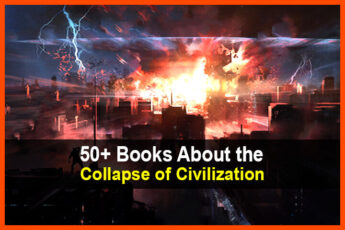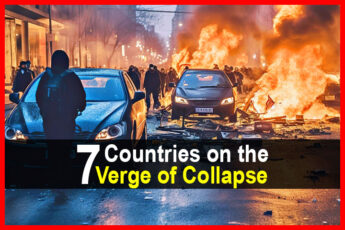Estimated reading time: 12 minutes
Look back over the past, with its changing empires that rose and fell, and you can foresee the future too.”
Marcus Aurelius, Roman Emperor 161 to 180 C.E.
Marcus Aurelius had it right, unfortunately. It seems that every civilization, in spite of its strengths, eventually succumbs to events beyond its control.
In some instances, archaeologists have been able to identify singular events that led to their collapse. In most instances, the collapse of civilizations was the result of compound disasters happening concurrently, or cascading disasters where one disaster led to another.
Want to save this post for later? Click Here to Pin It On Pinterest!
What, Exactly is a Civilization?
The dictionary makes it pretty clear. It’s when the stage of human social and cultural development is considered most advanced. Evidence of this stage was defined by the development of written language, complex mathematics, multiple technologies, industry, economies, and a defined political or ruling hierarchy.
Significantly, the development of advanced agricultural techniques and animal husbandry solved and satisfied basic nutritional needs, allowing the population to emerge from nomadic hunting and gathering behaviors. The ability to stay in one place empowered the construction of villages, cities, and some of the stunning monuments that defined these civilizations.
Cause for Collapse
The big question is, what events could cause these countries, empires, and civilizations to collapse? To answer that, we’ll take it from Aurelius and look back to the past.
However, there’s some disagreement about factors that led to the collapse of many civilizations. Some historical records are clear, like the Spaniard conquest and ultimate extermination of the Aztec and Inca civilizations. But many ancient events remain clouded in mystery with only carbon dating to correlate worldwide weather patterns, remaining geological evidence, and the vague clues of buried artifacts.
Few written records remain, so it’s an evolving mystery. But archaeologists are good detectives and if many of their conclusions are true, it’s an ominous sign for our modern way of life.
The Indus Civilization (3300 to 1300 B.C.E. – 3,000 years)
The Indus civilization was located across the length of modern day Pakistan and Northwest India. It was largely dependent on the Indus river that flowed through the Indus valley.
The people who populated the area were known as the Harappan. At its peak, 60,000 people lived in the Indus valley. They were one of the first to develop an accurate system of weights and measures, advance the use of metals including copper, bronze and tin, and master the use of stone and terracotta to design and construct massive structures.
Their most significant achievement was the design and construction of two cities: Mohenjo-Daro and Harappa. Both demonstrated complex ideas related to urban planning including plumbing. Their language still exists as hieroglyphs that to this day remain un-deciphered. For a civilization that existed 5,000 years ago, their accomplishments were remarkable – and then they collapsed.
Cause of Collapse of the Indus Civilization
Archaeologists are in agreement: climate change. Like many primitive societies, the Harappan were highly dependent on farming to feed their population. The regular flooding of the Indus valley by the Indus River fertilized and irrigated broad swaths of farmland.
This flooding event was driven by the arrival of seasonal monsoon rains. And then the monsoons stopped. Geological evidence from chemical analysis of cave stalactites and core samples from the mouth of the Indus River confirmed the change in climate and the regular arrival of monsoons.
The result was that the people abandoned the cities to pursue farming in the Himalayan mountains, but the monsoons in that region soon stopped and the population and their once great civilization quickly vanished. The cause of the climate change was driven by colder air swooping down from the Arctic, causing weather patterns to shift, resulting in reduced frequency and intensity of monsoons in the valley.
The Mayans (1500 B.C.E. to 900 C.E.- 2,400 years)
The Mayan civilization was located in Central America across the Isthmus of Panama to Yucatan and across Guatemala, Honduras, Belize, and El Salvador.
At its peak, it’s believed that the Mayan population reached 2 million and possibly as high as 10 million people. Those population numbers make the Indus Valley civilization of 60,000 sound like a suburb.
The achievements of the Mayans are truly remarkable including pyramids that rival the ancient Egyptians. The pyramid at Chichen Itza stands to this day.
Mayan accomplishments include remarkable cities across central America, the development of a complex written language consisting of hieroglyphs, a sophisticated mathematical system that included the first invention and the concept of zero.
They were also astute astronomers, and the combination of their astronomical observations and mastery of mathematics resulted in a sophisticated calendar that was a first for its time.
In addition to imposing pyramids, the Maya built vast irrigation canals, temples, palaces, and astronomical observatories. Their accomplishments rivaled any in the ancient world – and then it all fell apart.
Cause of Collapse of the Mayan Civilization
Once again, there is general agreement from archaeologists on the cause of the collapse of the Mayan civilization, only this time it was a combination of two factors: climate change and the over-exploitation of natural resources.
Once again, drought caused by shifting weather patterns left the irrigation canals high and dry, while their over-use of the surrounding forests and wildlife left them without alternatives when their crops failed. Compounding events was the enormous population numbering in the millions.
The lack of water compromised sanitation and disease and epidemics soon followed. Civil unrest wasn’t far behind, and the cities were quickly abandoned as the population turned to the distant countryside to survive. Parts of the Mayan population still reside across areas in Central America, and some still speak the ancient language, but that’s all that remains of one of the greatest early civilizations.
On a curious side note, the Mayan calendar abruptly ended in the year 2012. Some of you may recall the hysteria surrounding that date and that year. As for the Maya, their demise happened much sooner, around the year 900.
The Anasazi (100 to 1600 C.E. – 1,500 years)
The Anaszi were located at the 4 corners of Utah, Colorado, New Mexico and Arizona. At their peak, the total population was estimated at 30,000. Their most notable accomplishment was their architecture. A famous Anasazi archaeological site is Chaco Canyon in western New Mexico.
It featured a complex of buildings measuring as high as 5 stories built into the side of a cliff. The Anasazi were also gifted astronomers and built numerous observatories across their territory.
Their engineering feats went beyond the construction of the world’s first high-rise buildings to a network of roads crisscrossing 400 miles and up to 30 feet wide.
They left behind mysterious artwork that some say evoke alien visitation, although there is no evidence that the Anasazi civilization were spirited away to another planet.
The name “Anasazi” is a controversial expression. It’s literally translated as “ancient enemy.” The Pueblo tribe are the descendants of the Anasazi and they take exception to this designation. The Anasazi name was actually an invention of a local rancher in the 1800’s who often wandered across the ruins.
Regardless of the controversy, the civilization they developed was stunning and so was their rapid decline and disappearance.
Cause of Collapse of the Anasazi
It’s been determined that climate change once again led to the demise of this civilization. The result was massive drought compounded by the exhaustion of the surrounding natural resources including deforestation, eroded soil, and over-hunting of the local wildlife.
When farming failed, the population starved and once again, migration from the cities and communities was the only solution for survival.
As various groups migrated to the mountains, civil unrest emerged as warring groups fought for resources and the few viable plots of land that the mountains provided. The warring continued for generations and by 1450, a scarce few communities existed in modest villages scattered across the territory.
The Easter Islanders (700 to 1680 C.E. – 980 years)
Easter Island is a South Pacific Island located 2,200 miles west of Chile. It is mostly known for its brooding statues carved and transported to a standing position staring out to sea.
The islanders referred to these mysterious statues as Moai (pronounced MOE-EYE). The engineering required to move these stone giants has still left archaeologists puzzled, but one mystery has been solved: why the Easter Island civilization collapsed.
Cause of Collapse of the Easter Islanders
It wasn’t climate change. It was the other leading cause of collapse for many civilizations: the over-exploitation of natural resources.
The Easter Islanders had become so obsessed with the construction and erection of moai on their island that they clear cut ever tree from the island to transport and raise them. In fact, if you look at pictures of Easter Island today, it’s apparent that trees are never a part of the current landscape.
The deforestation of the island compromised the entire ecosystem, and over-hunting of wildlife left the island barren of resources, resulting in starvation. Fishing in the surrounding ocean was not an option. The northern part of the island was bordered by steep cliffs, and the Southern part of the island was exposed to cooler, deep water with few fish.
Building boats and rafts for fishing was not an option either. The trees were gone. Worse, the inability to build boats or rafts removed the last desperate option that most other failed civilizations followed – the ability to migrate to a better location.
As a result, the Easter Islanders were trapped and doomed to starve on an island thousands of miles away from the rest of the world. The few who survived subsisted on rats.
The Vikings/Greenland (985 to 1450 C.E. – 465 years)
The Viking settlements on Greenland were located along the south-western fjords. The Vikings were known to fearlessly travel the ocean and evidence of their settlements have been found in Newfoundland in North America long before Columbus stumbled into the Caribbean, believing he was in India.
One of the eventual destinations for these many Viking adventures was Greenland and they couldn’t have picked a better time. The weather was generally moderate in the southwest of Greenland and the land and hills surrounding the fjords was lush and green due to steady rainfall.
The Viking settlement on Greenland (it wasn’t really a civilization but a settlement) endured for more than 400 years. And then it collapsed as fast as it started.
Cause of Collapse of the Greenland Viking Settlement
Once again, climate change. Only this time the result wasn’t a drought but something called “The Little Ice Age.” It’s believed that an increase in volcanic activity worldwide clouded the atmosphere, cutting off the amount of sunlight. Adding to the dilemma was a general reduction in overall solar output from the sun plus a shift in the prevailing winds.
The end result was a cold period that swept the Northern and Southern hemisphere with cold temperatures that shortened the growing season, leading to general failure of agriculture anywhere.
Greenland was already fairly limited as an agricultural location, and the Little Ice Age reduced the pastures and forests to deserts of snow and ice. In fact, the end result of
The Little Ice Age climate change was drought.
The Vikings didn’t take long to evaluate the destruction of their once proud settlement and either turned to their long ships to return home or simply starved and died.
The Cahokia (950 to 1350 C.E. – 400 years)
The Cahokia civilization was located in the Midwestern United States, northeast of St. Louis, Missouri, and prominently in southern Illinois. It’s actually inaccurate to refer to this civilization as Cahokia. Their actual name is lost to time and the name “Cahokia” was the name given to the area when Dutch settler’s arrived there in the late 1600’s. By then, the original inhabitants were long gone., as well as their true name and history.
All that remains in Cahokia are some remarkable ruins in the shape of earthen mounds.
What’s significant about the primary mound is that its base is greater than the great pyramids in Egypt.
Excavations of the site and the surrounding area, in addition to Lidar scanning, reveal a major city with a population estimated at 50,000. The surveys also revealed the existence of 120 mounds in total with some rising to 100 feet as the tallest structure in North America at the time.
Cause of Collapse of the Cahokia
This time, events fell into the category of cascading disasters. The trigger was over-exploitation of natural resources, starting with deforestation. The loss of forest led to erosion and the loss of arable topsoil and farmland. Over-hunting again decimated the local wildlife. And then there was that Little Ice Age.
The demise of the Cahokia corresponded to the same chilling events affecting Greenland’s Vikings. What little farmland remained withered and died in a shortened growing season and ever decreasing temperatures.
Immigration became another solution, but as groups relocated, they turned to raiding each other for the few remaining resources. Call it civil unrest, but the sudden appearance of stockades around settlements indicated a new threat to the Cahokia.
Over time, the need to migrate to other locations became the only solution as the Cahokia people faded into the landscape and the civilization dissolved into time.
Lessons Learned?
There’s no shortage of civilizations that have collapsed across the recorded history of the world. In fact, it’s estimated that across history, the average duration of a civilization is 240 years. That’s a troubling average. More troubling is how bound and determined we are to repeat the mistakes of the past while ignoring the fundamental facts surrounding us.
Here are a few:
- Climate change is real and has impacted civilizations across times and places. Forget about what caused it—just know it happens and appears to be happening again.
- Exhaustion and over-exploitation of resources is a constant pattern in collapse events. From peak oil to global deforestation, we are consuming more than is available and literally carving the lungs out of the planet with every tree we lose.
- Over-hunting and harvesting is driving many species to extinction from the indiscriminate harvesting of fish across the world’s oceans to a general extinction of animals from pollinating insects to wildlife.
- Population growth has taken the world to over 8 billion people, and the population density not only increases the threat of contagious disease but imposes continuing demands on all resources.
- Immigration continues to be the last futile act of desperate people forced to abandon their homes to simply find somewhere else they can survive.
- Civil unrest and war appear to be inevitable conclusions as desperation turns to violence when no alternatives become apparent.
Those fundamental facts actually formed the benchmark for a study by MIT that was later validated by Yale University. They used super-computers to evaluate how to respond to those events and deal with them. They were stunned by what their computer models reported. It determined that today’s global civilization would collapse in 2040.
It’s troubling to ponder. But then, maybe we should begin where we started when Marcus Aurelius said:
“Look back over the past, with its changing empires that rose and fell, and you can foresee the future too.”
Like this post? Don't Forget to Pin It On Pinterest!








